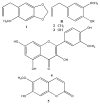Isolation, Gastroprotective Effects and Untargeted Metabolomics Analysis of Lycium Minutifolium J. Remy (Solanaceae)
- PMID: 32375270
- PMCID: PMC7278853
- DOI: 10.3390/foods9050565
Isolation, Gastroprotective Effects and Untargeted Metabolomics Analysis of Lycium Minutifolium J. Remy (Solanaceae)
Abstract
Lycium minutifolium J. Remy (Solanaceae) is commonly used as an infusion in traditional medicine to treat stomach pain, meteorism, intestinal disorders, stomach ailments, and other severe problems including prostate cancer and stomach cancer. From the EtOAc extract of L. minutifolium bark five known metabolites were isolated using chromatographic techniques. The gastroprotective effects of the EtOAc fraction and edible infusion extract of the bark were assayed on the hydrochloric acid (HCl)/EtOH induced gastric ulcer model in mice to support the traditional use of the plant. The EtOAc extract and the edible infusion showed gastroprotective effect at dose of 100 mg/kg reducing lesions by 31% and 64%, respectively. The gastroprotective action mechanisms of the edible infusion at a single oral dose of 100 mg/kg were evaluated suggesting that prostaglandins, sulfhydryl groups, and nitric oxide are involved in the mode of gastroprotective action. The UHPLC analysis coupled to high-resolution mass spectrometry of the edible infusion showed the presence of twenty-three compounds. Our results can support the gastroprotective properties of the edible infusion extract, and at least can validate in part, the ethnopharmacological uses of the plant.
Keywords: HPLC-MS; Lycium; coumarins; endemic plants; metabolomic; orbitrap; secondary metabolites.
Conflict of interest statement
The authors do not have any conflict of interest.
Figures
References
-
- Mozsik G.Y., Abdel-Salam O.M.E., Szolcsanyi J. Capsaicin-Sensitive Afferent Nerves in Gastric Mucosal Damage and Protection. Budapest Akadémiai Kiadó; Budapest, Hungary: 1997.
Grants and funding
LinkOut - more resources
Full Text Sources





